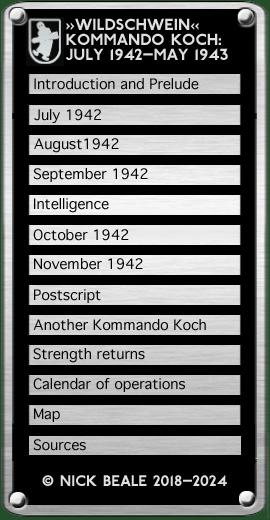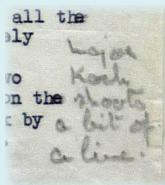|
Protekt Although the name Protekt was cited in reports from RAF Middle East, the 6N+AJ prisoners had only spoken of the Sondergerät (special set) but it seems it was the same as Dr. Scholz’s Kobold (see above). Operating on 100–250 mHz (Scholz gave the frequency range as 160–200 mHz) and retunable in flight, the system was said to provide all-round coverage to a radius of 100–150 km and to be effective against night fighter R/T as well as AI and ASV sets. Some prisoners thought that ground radars might also be jammed by it. Another feature of Protekt was that it interfered only minimally with the carrier aircraft’s own W/T and R/T, producing no more than a slight buzzing. The internal installation consisted of a monitoring unit, four VHF transmitters, each fed by a rotary converter, and four receivers; one of the units (at 30 x 25 x 50 cm) was larger than the rest. These components were fitted to the bulkhead in front of the air gunner and controlled by a second wireless operator. None of these items bore any markings or serial numbers, suggesting that they were not in series production. The set’s operator sat beneath the Bordfunker and his information on active British frequencies was updated in flight by the WIM station at Kounavi. The operator used his receiver to check which British frequencies were active, then tuned and activated a transmitter (with a simple on/off switch, the jamming intensity was not variable). The system could operate for at least four hours before overheating but consumed so much power that if all four transmitters were running and the Heinkel was on autopilot, the R/T and W/T could not be used. There was concern that the transmitters’ mercury-vapour oscillators gave off an intense blue-white light, some operators rigging a blanket to prevent this betraying the aircraft to night fighters. Different descriptions were offered of the aerial array, either: Three transmitter masts on top of the fuselage and two “Dipol X” receivers, on sides outboard of the Wireless Operator’s cabin; or Two 20 cm vertical rods atop the fuselage, each carrying two 40 cm elements, set at right angles and with one arm of the resulting “X” aligned nose-to-tail, plus “one or two horizontal dipoles about 70 cm long, carried on feeders about 10 cm in length” on the fuselage sides. In captivity, Klostermann and Pallada were recorded talking shop with a Ju 88 gunner captured on 29 June 1942. After praising FuG 10 as “a brilliant piece of kit”, Klostermann went on to talk of flying with “this Protekt gear—this jamming set against night fighters—and the jamming devices against the ship search set”. He dsiclaimed detailed knowledge of its workings, saying that it jammed night fighter R/T, even if it didn’t affect AI. The Ju 88 crewman pointed out that one had to know the relevant frequencies in order to jam them, Klostermann explaining that they were given out by the WIM-Zentrale. He couldn’t remember what WIM was an abbreviation for although “they [i.e. his interrogators] want to know that here too … they’re really hot on that”. He went on to describe—somewhat disjointedly—how Protekt was used on operations: So when the night fighter’s intercepting and wants to switch his set on, then it destroys his whole beam … If one of them switches on his set on the … then right away this beam is thwarted by the jammng set … On a given night the frequencies for all the night fighters are the same … first the WIM-Zentrale [is] on to it and second the man up aloft in the machine likewise has a receiver and he searches with this [and he] can establish it … there are four transmitters in the machine, so you can jam four frequencies. For instance so if they realise “Hang on, the frequency is jammed” … they go over to another one [so the Protekt operator] follows and jams that … Pallada asked if eight wavelengths could be jammed and being told no, countered that it had indeed happened. Klostermann, apparently realising what he meant answered: “One night [there were] two of us: one was flying at 2,000 [m] and we were at 3,000”.
On operations Aircraft equipped with ASV were being used defensively, to protect convoys. The special operator tried to maintain radar contact with the ships while watching for the approach of hostile aircraft or vessels. The crew of 6N+AJ had flown an ASV sortie escorting a convoy between Derna and Benghazi on a parallel course 10 km to seaward and turning toward the ships every five minutes, making continuous figure-eights. The prisoners claimed that toward the end of August, Maj. Koch had been flying his Kommando’s Do 217 on escort for a convoy between Greece and Tobruk. In the course of this sortie he had not only shot down two British aircraft but forced RN submarines to dive every time they appeared on the surface. Someone in RAF Intelligence pencilled a laconic assessment against this passage: ”Major Koch shoots a bit of a line.” Koch was also said to fly on all raids over the Nile Delta, with two Protekt aircraft assigned each time, one covering the northern and one the southern area (where the RAF had encountered no jamming as of early October). Dümmler’s crew had done three such raids, always covering the north by flying back and forth along a 100 km track about 30 km offshore. Crews were briefed on the British frequencies monitored from the ground by the »WIM-Bodenstellen« which would themselves be jamming to support the bombers. In the air the »WIM-Funker« would listen periodically to see if the British had changed frequencies, reset his transmitters as necessary and start broadcasting again. As on convoy operations, the aircraft and ground stations would continually update one another. A pilot’s view Klostermann and Pallada’s testimony was deemed of such value that they were taken to England for further questioning. In the Middle East their pilot, Helmut Dümmler voiced his own ugly opinions on prisoner interrogation to Uffz. Hermann Flendt of 9./JG 27—and to concealed microphones: (Flendt) It’s a lucky thing for you that, speaking such good French, you weren’t taken prisoner by the French. They’d have shot you on the spot. (Dümmler) Oh no, they wouldn’t have. It’s more important to them to get information from us. For instance, if I were to capture a company, I should keep the Company Commander and the Sergeant and one or two others and then I’d shoot a few, to make the others spill the beans. Of course if I took a General prisoner I wouldn’t shoot him, but naturally I’d shoot any Jews that I captured. continued on next page …
|
|||


